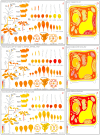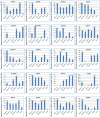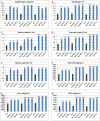Harnessing de novo transcriptome sequencing to identify and characterize genes regulating carbohydrate biosynthesis pathways in Salvia guaranitica L
- PMID: 39391775
- PMCID: PMC11464306
- DOI: 10.3389/fpls.2024.1467432
Harnessing de novo transcriptome sequencing to identify and characterize genes regulating carbohydrate biosynthesis pathways in Salvia guaranitica L
Abstract
Introduction: Carbohydrate compounds serve multifaceted roles, from energy sources to stress protectants, found across diverse organisms including bacteria, fungi, and plants. Despite this broad importance, the molecular genetic framework underlying carbohydrate biosynthesis pathways, such as starch, sucrose, and glycolysis/gluconeogenesis in Salvia guaranitica, remains largely unexplored.
Methods: In this study, the Illumina-HiSeq 2500 platform was used to sequence the transcripts of S. guaranitica leaves, generating approximately 8.2 Gb of raw data. After filtering and removing adapter sequences, 38 million reads comprising 210 million high-quality nucleotide bases were obtained. De novo assembly resulted in 75,100 unigenes, which were annotated to establish a comprehensive database for investigating starch, sucrose, and glycolysis biosynthesis. Functional analyses of glucose-6-phosphate isomerase (SgGPI), trehalose-6-phosphate synthase/phosphatase (SgT6PS), and sucrose synthase (SgSUS) were performed using transgenic Arabidopsis thaliana.
Results: Among the unigenes, 410 were identified as putatively involved in these metabolic pathways, including 175 related to glycolysis/gluconeogenesis and 235 to starch and sucrose biosynthesis. Overexpression of SgGPI, SgT6PS, and SgSUS in transgenic A. thaliana enhanced leaf area, accelerated flower formation, and promoted overall growth compared to wild-type plants.
Discussion: These findings lay a foundation for understanding the roles of starch, sucrose, and glycolysis biosynthesis genes in S. guaranitica, offering insights into future metabolic engineering strategies for enhancing the production of valuable carbohydrate compounds in S. guaranitica or other plants.
Keywords: Salvia guaranitica; functional characterization; gluconeogenesis; glycolysis; starch; sucrose; transcriptome; transgenic Arabidopsis thaliana.
Copyright © 2024 Abbas, Al-Huqail, Abdel Kawy, Abdulhai, Albalawi, AlShaqhaa, Alsubeie, Darwish, Abdelhameed, Soudy, Makki, Aljabri, Al-Sulami, Ali and Zayed.
Conflict of interest statement
The authors declare that the research was conducted in the absence of any commercial or financial relationships that could be construed as a potential conflict of interest. The reviewer OH declared a past co-authorship with the author MA, and declared a shared affiliation with the author MZ to the handling editor at the time of the review.
Figures







Similar articles
-
De novo transcriptome sequencing and metabolite profiling analyses reveal the complex metabolic genes involved in the terpenoid biosynthesis in Blue Anise Sage (Salvia guaranitica L.).DNA Res. 2018 Dec 1;25(6):597-617. doi: 10.1093/dnares/dsy028. DNA Res. 2018. PMID: 30188980 Free PMC article.
-
Transcriptome and metabolite analyses reveal the complex metabolic genes involved in volatile terpenoid biosynthesis in garden sage (Salvia officinalis).Sci Rep. 2017 Nov 22;7(1):16074. doi: 10.1038/s41598-017-15478-3. Sci Rep. 2017. PMID: 29167468 Free PMC article.
-
De novo transcriptome assembly of the wild relative of tea tree (Camellia taliensis) and comparative analysis with tea transcriptome identified putative genes associated with tea quality and stress response.BMC Genomics. 2015 Apr 15;16(1):298. doi: 10.1186/s12864-015-1494-4. BMC Genomics. 2015. PMID: 25881092 Free PMC article.
-
Comprehensive transcriptome analysis of Crocus sativus for discovery and expression of genes involved in apocarotenoid biosynthesis.BMC Genomics. 2015 Sep 15;16(1):698. doi: 10.1186/s12864-015-1894-5. BMC Genomics. 2015. PMID: 26370545 Free PMC article.
-
Transcriptome analysis of starch and sucrose metabolism across bulb development in Sagittaria sagittifolia.Gene. 2018 Apr 5;649:99-112. doi: 10.1016/j.gene.2018.01.075. Epub 2018 Jan 31. Gene. 2018. PMID: 29374598 Review.
Cited by
-
Physiological and transcriptomic evaluation of salt tolerance in Egyptian tomato landraces at the seedling stage.BMC Plant Biol. 2025 Apr 22;25(1):507. doi: 10.1186/s12870-025-06358-4. BMC Plant Biol. 2025. PMID: 40259234 Free PMC article.
References
-
- Abdelhameed A. A., Ali M., Darwish D. B. E., AlShaqhaa M. A., Selim D. A.-F. H., Nagah A., et al. . (2024. a). Induced genetic diversity through mutagenesis in wheat gene pool and significant use of SCoT markers to underpin key agronomic traits. BMC Plant Biol. 24, 673. doi: 10.1186/s12870-024-05345-5 - DOI - PMC - PubMed
-
- Abdelhameed A. A., Eissa M. A., El-kholy R. I., Darwish D. B. E., Abeed A. H. A., Soudy F. A., et al. . (2024. b). Molecular cloning and expression analysis of geranyllinalool synthase gene (SgGES) from salvia guaranitica plants. Horticulturae 10, 668. doi: 10.3390/horticulturae10070668 - DOI
-
- Abd El-Wahab M., Toaima W., Hamed E. (2015). Effect of different planting locations in Egypt on salvia fruticosa mill. Plants. Egypt. J. Desert Res. 65, 291–307. doi: 10.21608/ejdr.2015.5955 - DOI
-
- Ahmed M., Shahid A. A., Akhtar S., Latif A., Din S., Fanglu M., et al. . (2018). Sucrose synthase genes: a way forward for cotton fiber improvement. Biol. (Bratisl). 73, 703–713. doi: 10.2478/s11756-018-0078-6 - DOI
LinkOut - more resources
Full Text Sources

